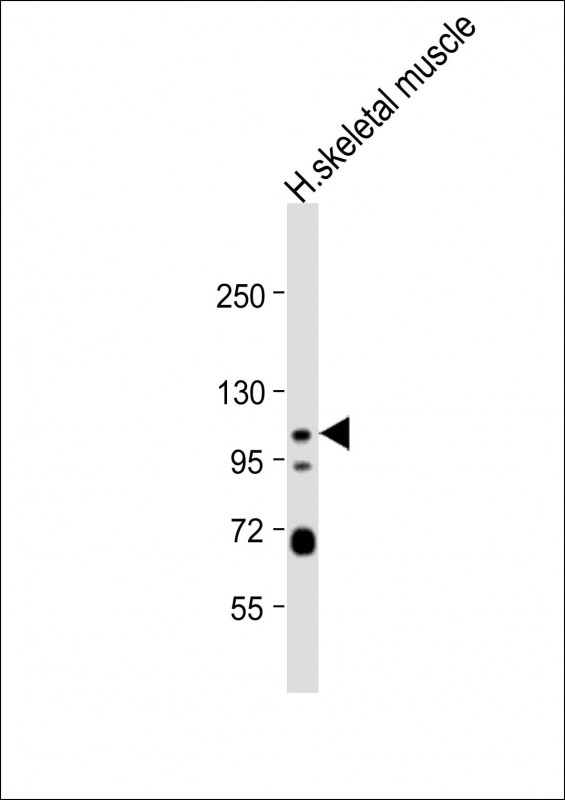KCNQ5 Antibody (C-term)
Affinity Purified Rabbit Polyclonal Antibody (Pab)
- 产品详情
- 实验流程
- 背景知识
Application
| WB, E |
|---|---|
| Primary Accession | Q9NR82 |
| Other Accession | NP_001153602.1, NP_001153604.1 |
| Reactivity | Human, Mouse |
| Host | Rabbit |
| Clonality | Polyclonal |
| Isotype | Rabbit IgG |
| Calculated MW | 102179 Da |
| Antigen Region | 781-809 aa |
| Gene ID | 56479 |
|---|---|
| Other Names | Potassium voltage-gated channel subfamily KQT member 5, KQT-like 5, Potassium channel subunit alpha KvLQT5, Voltage-gated potassium channel subunit Kv75, KCNQ5 |
| Target/Specificity | This KCNQ5 antibody is generated from rabbits immunized with a KLH conjugated synthetic peptide between 781-809 amino acids from the C-terminal region of human KCNQ5. |
| Dilution | WB~~1:1000 E~~Use at an assay dependent concentration. |
| Format | Purified polyclonal antibody supplied in PBS with 0.09% (W/V) sodium azide. This antibody is purified through a protein A column, followed by peptide affinity purification. |
| Storage | Maintain refrigerated at 2-8°C for up to 2 weeks. For long term storage store at -20°C in small aliquots to prevent freeze-thaw cycles. |
| Precautions | KCNQ5 Antibody (C-term) is for research use only and not for use in diagnostic or therapeutic procedures. |
| Name | KCNQ5 (HGNC:6299) |
|---|---|
| Function | Pore-forming subunit of the voltage-gated potassium (Kv) channel broadly expressed in brain and involved in the regulation of neuronal excitability (PubMed:10787416, PubMed:10816588, PubMed:11159685, PubMed:28669405). Associates with KCNQ3/Kv7.3 pore- forming subunit to form a potassium channel which contributes to M-type current, a slowly activating and deactivating potassium conductance which plays a critical role in determining the subthreshold electrical excitability of neurons (PubMed:10816588, PubMed:11159685). Contributes, with other potassium channels, to the molecular diversity of a heterogeneous population of M-channels, varying in kinetic and pharmacological properties, which underlie this physiologically important current (PubMed:10816588). Also forms a functional channel with KCNQ1/Kv7.1 subunit that may contribute to vasoconstriction and hypertension (PubMed:24855057). Channel may be selectively permeable in vitro to other cations besides potassium, in decreasing order of affinity K(+) = Rb(+) > Cs(+) > Na(+) (PubMed:10816588). Similar to the native M-channel, KCNQ3-KCNQ5 potassium channel is suppressed by activation of the muscarinic acetylcholine receptor CHRM1 (PubMed:10816588). |
| Cellular Location | Cell membrane; Multi-pass membrane protein |
| Tissue Location | Strongly expressed in brain and skeletal muscle (PubMed:10787416, PubMed:10816588). In brain, expressed in cerebral cortex, occipital pole, frontal lobe and temporal lobe. Lower levels in hippocampus and putamen. Low to undetectable levels in medulla, cerebellum and thalamus (PubMed:10787416, PubMed:10816588) |
For Research Use Only. Not For Use In Diagnostic Procedures.
Provided below are standard protocols that you may find useful for product applications.
BACKGROUND
This gene is a member of the KCNQ potassium channel gene family that is differentially expressed in subregions of the brain and in skeletal muscle. The protein encoded by this gene yields currents that activate slowly with depolarization and can form heteromeric channels with the protein encoded by the KCNQ3 gene. Currents expressed from this protein have voltage dependences and inhibitor sensitivities in common with M-currents. They are also inhibited by M1 muscarinic receptor activation. Multiple transcript variants encoding different isoforms have been found for this gene.
REFERENCES
Bailey, S.D., et al. Diabetes Care (2010) In press :
Rose, J.E., et al. Mol. Med. 16 (7-8), 247-253 (2010) :
Talmud, P.J., et al. Am. J. Hum. Genet. 85(5):628-642(2009)
Roura-Ferrer, M., et al. Cell. Physiol. Biochem. 24 (5-6), 325-334 (2009) :
Bal, M., et al. J. Biol. Chem. 283(45):30668-30676(2008)
终于等到您。ABCEPTA(百远生物)抗体产品。
点击下方“我要评价 ”按钮提交您的反馈信息,您的反馈和评价是我们最宝贵的财富之一,
我们将在1-3个工作日内处理您的反馈信息。
如有疑问,联系:0512-88856768 tech-china@abcepta.com.























 癌症的基本特征包括细胞增殖、血管生成、迁移、凋亡逃避机制和细胞永生等。找到癌症发生过程中这些通路的关键标记物和对应的抗体用于检测至关重要。
癌症的基本特征包括细胞增殖、血管生成、迁移、凋亡逃避机制和细胞永生等。找到癌症发生过程中这些通路的关键标记物和对应的抗体用于检测至关重要。 为您推荐一个泛素化位点预测神器——泛素化分析工具,可以为您的蛋白的泛素化位点作出预测和评分。
为您推荐一个泛素化位点预测神器——泛素化分析工具,可以为您的蛋白的泛素化位点作出预测和评分。 细胞自噬受体图形绘图工具为你的蛋白的细胞受体结合位点作出预测和评分,识别结合到自噬通路中的蛋白是非常重要的,便于让我们理解自噬在正常生理、病理过程中的作用,如发育、细胞分化、神经退化性疾病、压力条件下、感染和癌症。
细胞自噬受体图形绘图工具为你的蛋白的细胞受体结合位点作出预测和评分,识别结合到自噬通路中的蛋白是非常重要的,便于让我们理解自噬在正常生理、病理过程中的作用,如发育、细胞分化、神经退化性疾病、压力条件下、感染和癌症。







